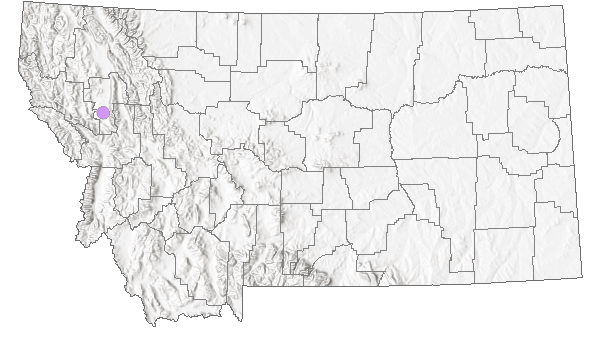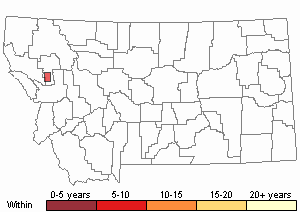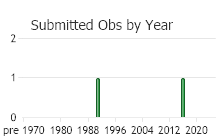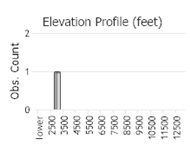View in other NatureServe Network Field Guides
NatureServe
Montana
Utah
Wyoming
Idaho
Wisconsin
British Columbia
South Carolina
Yukon
California
New York
Pepperwort - Marsilea oligospora
State Rank Reason (see State Rank above)
Marsilea oligospora has relatively recently been segregated from Marsilea vestita (FNA 1993). It is quite common around Ninepipes National Wildlife Refuge, but has not been documented elsewhere in Montana. Observation data is greatly needed to further assess its distribution and viability in Montana.
- Details on Status Ranking and Review
Range Extent
ScoreA - <100 sq km (< ~40 sq mi)
Area of Occupancy
ScoreD - 6-25 4-km2 grid cells
Number of Populations
ScoreB - 6 - 20
Number of Occurrences or Percent Area with Good Viability / Ecological Integrity
ScoreC - Few (4-12) occurrences with excellent or good viability or ecological integrity
Environmental Specificity
ScoreB - Narrow. Specialist or community with key requirements common
Threats
ScoreB - High
CommentThreat category includes: Noxious weeds (potential) and hydrologic alterations (potential).
General Description
PLANTS: Perennial, aquatic ferns that form colonies from shallow, branched rhizomes (Lesica et al. 2012).
LEAVES: Plants have alternate, clover-like, photosynthetic leaves. Leaf petioles are longer than the blades, which are palmately divided into 4 equal, broadly ovate, pilose pinnae (Lesica et al. 2012).
SPOROCARPS: Nut-like or bean-shaped structures found attached the bases of petioles. Sporocarps slightly nod and may be stalked. Inside the sporocarp, the sori are arranged in 2 alternating rows (Lesica et al. 2012). Each sorus contains microsporangia and megasporangia (Nagalingum et al. 2007). Refer to REPRODUCTIVE CHARACTERISTICS.
The specific epithet oligospora is a combination of the Greek oligos, meaning “oligarchy” or “few”, and the Latin spora, meaning “spores,” “seeds,” or “to sow”. Marsilea is for Count Luigi Marsigli, an Italian naturalist and mycologist of the 18th century (Giblin et al. [eds.] 2018).
Phenology
Sporocarps are produced from June through October (Johnson in Flora of North America 2019).
Diagnostic Characteristics
Montana has 2 native species of
Marsilea. Both are aquatic perennials that from colonies from shallow, branched rhizomes. The leaves of both species are alternate and clover-like, the blades divided into 4 broadly ovate pinnae which, all together, are shorter than the petiole.
Pepperwort-
Marsilea oligospora, native, SOC
*Leaf petioles: 3-6 cm long
*Pinnae: 6-15 mm long and pilose.
*Sporocarps: Mature sporocarps are 5-6 mm long, nodding and long-hairy but glabrous with age.
*Sporocarp teeth: The lower tooth is usually about 0.5 mm long while the upper is usually blunt and smaller than the upper or absent.
Hairy Water Fern-
Marsilea vestita, native
*Leaf petioles: 1-20 cm long or up to 40 when floating.
*Pinnae: 3-19 mm long and sparsely pubescent to glabrous.
*Sporocarps: Mature sporocarps are 3-6 mm long, slightly nodding and pubescent but glabrous with age.
*Sporocarp teeth: The lower tooth is usually about 0.5 mm long while the upper tooth is longer and acute.
Species Range
Montana Range
Range Descriptions

 Native
Native
Range Comments
Pepperwort ranges from Washington south to California, and extends east to Montana, Wyoming and Utah (Lesica et al. 2012).
Observations in Montana Natural Heritage Program Database
Number of Observations: 3
(Click on the following maps and charts to see full sized version)
Map Help and Descriptions
Relative Density

Recency



 (Observations spanning multiple months or years are excluded from time charts)
(Observations spanning multiple months or years are excluded from time charts)
Habitat
The preferred habitat of Pepperwort is shallow water in valleys (Lesica et al. 2012). Pepperwort requires habitats that have both wet and dry seasonal periods (Chau et al. 2014).
Ecology
INUNDATION
Many Marsilea species require habitats with specialized periods of both dry and inundated conditions in order to complete their life cycle (Chau et al. 2014). Consequently, they most often grow in habitats that are seasonally dry and only become wet during the rainy season or where water levels fluctuate from one season to the next (Pryer et al. 2009).
in a California-based study of vernal pools Pepperwort was found to be an indicator species for “long inundated communities” (Gosejohan et al. 2017). Pepperwort requires an extremely specialized inundation period of at least 212 days. This plant required both the longest period of inundation and the narrowest range of inundation period suitable for reproduction when compared against all other examined species.
NYCTINASTY
Marsilea species are the only group of ferns that exhibit nyctinasty, or daily movement of leaf orientation (Petlewski et al. 2019). During the day, they assume a more or less horizontal position in order to maximize capture of sunlight and then change orientation by moving into a vertical position at night (Minorsky 2019). The mechanism by which this occurs is the pulvinus joint found at the swollen base of the leaf stalk which moves with water inflow or outflow to the pulvinus motor cells (Iwai et al. 2016). Nyctinastic movement in Marsilea species matches the rhythm of transpiration through opening and closing of stomata (Iwai et al. 2016).
PARASITISM
Parasitism by numerous insect species, including weevils from the genus Echinocnemus and several wasp species, has been observed on Marsilea mollis in Arizona (Mauz et al. 2009). Endalus celatus, another weevil species, has been associated with M. mucronata (Mauz et al. 2009). In these cases, adults feed on the edges of the leaves and females deposit their eggs in the sporocarps (Board et al. 1971). After hatching, larvae feed on the spores inside the sporocarps and then pupate in the resulting empty cavity (Board et al. 1971). Similar weevil and wasp interactions may exist for other Marsilea species.
Reproductive Characteristics
SPOROCARPS
Sporocarps are nut-like structures that are attached by a stalk to the bases of leaf petioles (Nagalingum et al. 2006). When they are young, sporocarps are softer and may be green but they become very hard and brown with age. Beneath the thick, hard wall of a mature sporocarp, there are 2 rows of sori all attached to a surrounding mucilaginous ring. Sporocarps are specialized reproductive structures that are infolded and fused to contain the sori (Pryer et al. 2009). These structures, unique to Marsileaceae, release individuals from the need to develop mature, sexual leaves and also allow them to become sexually mature earlier than other ferns (Pryer et al. 2009). This is an advantage particularly beneficial for organisms occupying habitats with uncertain conditions because once the conditions are favorable for reproduction, the individual is ready to germinate (Pryer et al. 2009).
SORI
Each bisporaginate sorus is surrounded by a thin indusium and contains two types of sporangium, megasporangium, which produce female gametophytes and microsporangium, which produce male gametophytes (Nagalingum et al. 2007). The indusia of adjacent sori are partially fused.
LIFE CYCLE
The life cycle of Marsilea are very unique in that they rely on the occurrence of both wet and dry periods to complete their reproductive life cycle (Chau et al. 2014). Germination of developed sporocarps occurs once the sori have matured and the entire sporocarp is hydrated during the rainy season, at which point the mucilaginous ring surrounding the sori expands dramatically and ruptures the sporocarp (Nagalingum et al. 2007). At this point spores germinate in a gametophytic phase of up to 2 days after which the sporophyte quickly develops rhizomes and leaves (Pryer et al. 2009). Development of new sporocarps follows the end of the growing season when the habitat dries completely (Pryer et al. 2009). Sporocarps are remarkable tolerant of desiccation and can germinate successfully even after 100 years of dormancy (Gosejohan et al. 2017).
Management
Extensive observation data of Pepperwort is needed to determine how management affects its status and biology in Montana.
Marsilea villosa is an endemic species to Hawaii and is listed as federally endangered (USDA Plants Database 2019). It is very closely related to M. vestita and M. oligospora (Wester et al. 2006). At many sites aggressive, invasive grass species are out competing M. villosa and managers have found that plants respond positively to mowing because it reduces its taller-growing competitors (Wester et al. 2006).
Stewardship Responsibility
Threats or Limiting Factors
Marsilea villosa is endemic to Hawaii and very closely related to M. vestita and M. oligospora. Marsilea villosa has experienced a drastic decrease in its range, which is most likely due to its narrow habitat requirements combined with human alteration and aggressive invasive species (Wester et al. 2006). This decline has occurred despite attempted conservation and management of populations (Wester et al. 2006). Off-road vehicles as well as trampling and grazing by cattle have also been suggested as contributing to its dwindling distribution (Wester et al. 2006).
STATE THREAT SCORE REASON
Threat impact not assigned because threats are not known (MTNHP Threat Assessment 2021).
References
- Literature Cited AboveLegend:
 View Online Publication
View Online Publication Lesica, P., M.T. Lavin, and P.F. Stickney. 2012. Manual of Montana Vascular Plants. Fort Worth, TX: BRIT Press. viii + 771 p.
Lesica, P., M.T. Lavin, and P.F. Stickney. 2012. Manual of Montana Vascular Plants. Fort Worth, TX: BRIT Press. viii + 771 p. MTNHP Threat Assessment. 2021. State Threat Score Assignment and Assessment of Reported Threats from 2006 to 2021 for State-listed Vascular Plants. Botany Program, Montana Natural Heritage Program, Helena, Montana.
MTNHP Threat Assessment. 2021. State Threat Score Assignment and Assessment of Reported Threats from 2006 to 2021 for State-listed Vascular Plants. Botany Program, Montana Natural Heritage Program, Helena, Montana.
- Additional ReferencesLegend:
 View Online Publication
View Online Publication
Do you know of a citation we're missing? Lesica, P., M.T. Lavin, and P.F. Stickney. 2022. Manual of Montana Vascular Plants, Second Edition. Fort Worth, TX: BRIT Press. viii + 779 p.
Lesica, P., M.T. Lavin, and P.F. Stickney. 2022. Manual of Montana Vascular Plants, Second Edition. Fort Worth, TX: BRIT Press. viii + 779 p.
- Web Search Engines for Articles on "Pepperwort"





